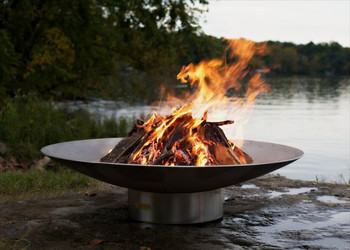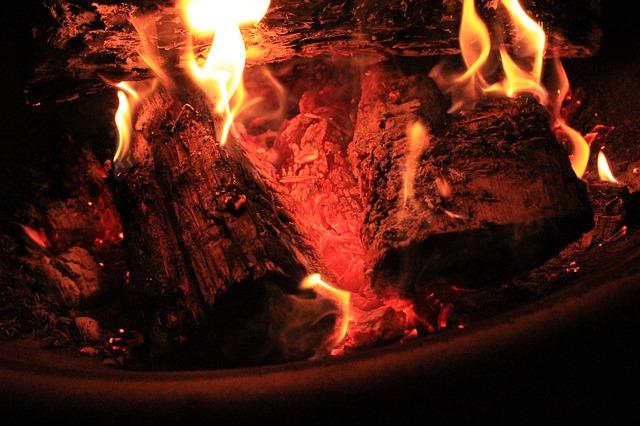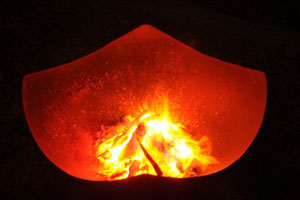The Best Wood To Burn In A Wood Burning Fire Pit - Part 2
Posted by The Fire Pit Store on 10th Sep 2017
Check out the coolest wood fire pits in the world right here!
The Best Wood To Burn In A Wood Burning Fire Pit - Part 2
So are some types of fire wood better than others? Sure, if you know what you like. But remember, an outdoor fire pit does not require a lot of maintenance and because of this you can afford to be a lot less fussy. Since there's no chimney to clean, there's no roof to catch fire if you forget. You can burn all the sappy, resinous wood you want, as hot as you like. You also don't have to worry about stray embers, smoke, ashes, or the usual mess wood can make in your house. Providing you take every safety recommendation seriously when choosing a location and assembling your pit, you're good. I am not hugely picky with what fire wood I use. I live on a budget and to me it's far better to just get outside and enjoy my fire pit with whatever local wood is available every year, rather than not use it at all because I can't afford that cord of black walnut I saw advertised on Craigslist. However, if money is no object for you, or if you're fortunate enough to live in a region where there are many
species of trees growing, I would totally go for the experience and try everything to see what I like best.
Without a doubt, there are certain types of wood that are pretty lame to deal with by any standard and are definitely at the bottom of my list. There are also many varieties that without question will give you a peak fire pit experience. Great firewood maximizes the ambiance of any setting and improves the quality of the time you spend outside. It can also save you loads of work in the way of splitting and storage, trying to light the fire and keep the fire going without too many trips to the wood pile.
Perfect Fire Wood
There's no perfect firewood, however. Every tree is different to varying degrees, and only by trying out different kinds over time will you learn what's best for any given situation. Do you have a bunch of friends who are cold and need a nice, roaring bonfire right away? A good, well-seasoned softwood like pine will nearly light itself and have you toasting in no time. Or would you prefer a quieter, more well-behaved fire that you can cuddle up real close to with someone special? That's where a nice hardwood comes in. It will produce the necessary heat and create the tamer, long-lasting atmosphere you're looking for.
Unfortunately, the situation is not always this cut and dried – sorry, no pun intended. What you want and what's available doesn't always line up. If the wood you have isn't properly seasoned, or if you can't find or afford the primo stuff, the good news is that there are still many medium-grade varieties that will work nearly as well if you understand their individual characteristics. Some types of what would be otherwise very decent, heat-producing wood may leave behind copious amounts of ash that you'll be constantly scooping out of your pit between uses. Some types of wood burn well but are impossible to split. Others are easy to split and burn well but are notorious for producing lots of sparks or smoke. Still others make a great bed of coals or smell incredible but have to be combined with other wood to keep it going.
The best way to understand the difference between different firewood is to approach through two main categories: hardwoods and softwoods. There are over 23,000 different species of trees in the world and it would be impossible to discuss them all. So, for time's sake I'm going to stick with the types of wood that you're most likely to come across if you live in the United States. But first let's look at what we mean by hardwoods and softwoods.
When you want a quieter, long-lasting flame, think hardwood. Hardwoods generally come from broad-leafed deciduous trees (maple, oak, etc.) whose mass is denser because they grow more slowly. Slow growth, slow fire. More concentrated wood to burn through.
Softwoods come from evergreens such as conifers (pine, spruce, etc.) whose leaves are needle-like. Softwoods are less dense and grow faster. Faster growth, faster-burning fire. Makes sense, right?
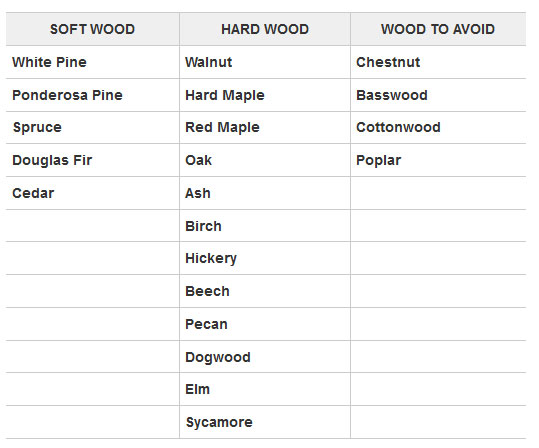
Hardwood and Softwood
Hardwoods and softwoods have the same amount of energy by mass and both are capable of putting out the same amount of heat. The main difference is the rate in which they release this energy. Hardwood is heavier by weight because it's more solid, and consequently releases its energy more slowly with a smaller flame - which is still plenty hot, by the way. Hardwood generally burns more cleanly with less smoke, ash, and creosote, which is why it's the preferred fuel for indoor wood stoves and fireplaces. It's also the preferred fuel for campfires and outdoor fire pits because it shoots out fewer sparks and tends to emit less smoke. And because you won't have that huge blaze that an equal amount of softwood can create, hardwood is easier to control and less of a fire hazard - especially on a breezy day.
Unlike hardwood, softwood ignites quickly and produces large, hot flames as it rapidly releases its energy. Softwoods are less dense and burn faster because they're porous, which means there's more space in between the molecules of wood. Softwoods are faster-growing and more porous in order to allow for the huge quantities of moisture and sap
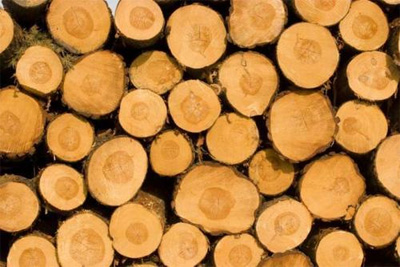 they need to grow themselves. Since its porousness makes it less dense, a piece of softwood, like pine, weighs much less than a similar size piece of hardwood, like oak. To equal the same amount of mass (density) and heat output of a stack of oak, you're going to need a substantially bigger stack of pine. That's why a cord of oak is going to be more expensive than a cord of pine. It would seem like you're getting more wood for the money if you buy the pine, but you're going to burn through it in no time. Another reason hardwoods cost more is that because of their slow rate of growth they're not easily renewable as a resource. Softwoods like pine and other conifers can be farmed and grown quickly in greater quantities, so the supply is always going to be more abundant which makes it less expensive and more available.
they need to grow themselves. Since its porousness makes it less dense, a piece of softwood, like pine, weighs much less than a similar size piece of hardwood, like oak. To equal the same amount of mass (density) and heat output of a stack of oak, you're going to need a substantially bigger stack of pine. That's why a cord of oak is going to be more expensive than a cord of pine. It would seem like you're getting more wood for the money if you buy the pine, but you're going to burn through it in no time. Another reason hardwoods cost more is that because of their slow rate of growth they're not easily renewable as a resource. Softwoods like pine and other conifers can be farmed and grown quickly in greater quantities, so the supply is always going to be more abundant which makes it less expensive and more available.
But not less desirable to those of us who use
fire pits. There's nothing wrong with a split stack of well-seasoned Ponderosa pine or Douglas fir. It splits and burns well, and most of us enjoy a little crackle and pop. Cedar sparks a bit more but puts out good heat and smells great. White pine has an exceptionally nice vanilla scent. Remember, you're not using it to heat your home throughout the winter. So creosote and cost effectiveness isn't a big issue. For occasional fire pit use these are probably the best choices around if you want to save money. Even if you prefer hardwoods, cedar and pine in the form of shakes and kindling are indispensable for starting your fire and keeping other harder woods going. It's always useful to have some around, but make sure it's well-seasoned. If you're going to collect or cut your own, you just need to remember that softwoods contain more moisture and are full of resinous sap so they take longer to dry out than hardwood. One type of softwood you might want to stay away from completely is spruce. It smokes and sparks a lot and doesn't put out much heat for the trouble.

